On our first visit to San Cristóbal de las Casas in 2015, we spent 2 days with Guide Juan José Cruz (shown below modeling a Tzetlal Mayor’s robe) touring weaving villages outside of the city.
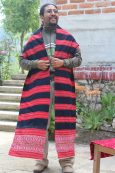 In the course of the days we spent touring those villages, Juan José asked if we had ever been to Magdalena; a village we heard referred to frequently in shops, textile museums & co-operatives in San Cristóbal. It is the home village of some of the best weaving we saw displayed in the city. When we replied that we hadn’t been there, Juan José suggested it was too far from the city to include with all the villages were visiting then but we should include it “On your next trip”. So when we returned to San Cristóbal in 2016, a visit to Magdalena was at the top of our list.
In the course of the days we spent touring those villages, Juan José asked if we had ever been to Magdalena; a village we heard referred to frequently in shops, textile museums & co-operatives in San Cristóbal. It is the home village of some of the best weaving we saw displayed in the city. When we replied that we hadn’t been there, Juan José suggested it was too far from the city to include with all the villages were visiting then but we should include it “On your next trip”. So when we returned to San Cristóbal in 2016, a visit to Magdalena was at the top of our list.
It’s often said that … “Sometimes it’s the journey that teaches you a lot about your destination” and this very much the case on this adventure so please forgive me if I spend too much time here describing that part of our day. If you just want to read about the weavers we met, you should skip to the bottom part of this page.
Magdalena is actually an old name for the village now known by most people as Aldama. Aldama is also the name of the municipality, something akin to a county with the village of (Magdalena or) Aldama as its largest town and seat of local government. Like San Andrés Larráinzar, Zinacantán and Chamula, the people living in Aldama are predominantly of Tzotzil descent so weaving motifs and dialects are similar among those villages.
In doing research for the visit, we came across references to a couple of master weavers who headed small co-ops in Aldama Municipality that we decided to try and find (with the help of Juan José); one in the small village formally known as Magdalena and the other in the even smaller village of Yetón. So we departed the city and set out throu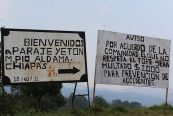 gh some beautiful countryside; up, down and around mountain passages.
gh some beautiful countryside; up, down and around mountain passages.
After about 2 hours as we entered the Aldama Municipality, we reached the top of a tall hill overlooking a wide valley below and found ourselves at a fork in the road. To the right was a narrow paved road to Magdalena and to the left a rocky and more treacherous looking dirt road down to the pueblo of Yetón.
Based as much on the road condition as anything else, we headed in the direction of Magdalena. We found a dusty village with dirt streets full of rocks and deep holes. We had the name of the weaver but no directions to her home so we headed to the zócalo located in front of the church and inquired of some men sitting in the shade on the edge of th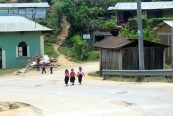 e square. They all said they did not know of the lady, which seemed odd given the small size of the town.
e square. They all said they did not know of the lady, which seemed odd given the small size of the town.
Even odder still, given the reputation of the village as the home of great weavers was that initially none of the men seemed acquainted with ANY weavers in the town. That just didn’t seem possible and after a few minutes of conversation, one man confided in Juan José that there was a weaver living near the opposite corner of the square so we headed in that direction. While we found her and she was working on some nice pieces, she was not the lady we were looking for and she didn’t seem to know her either.
So after spending a little time with her and spending a little more time looking for the lady we were looking for; we decided to head back up the road and try to find our Yetón weaver.
We, especially Juan José, were not looking forward to driving the steep grade over large rocks down to the village but we back-tracked to the top of the hill, made the turn and passed by one house when we saw some men a few hundred yards down the road cutting firewood. We stopped and asked them if they knew the weaver Francisca Santiz Gómez and one of the men said “Well yes I know her. She is married to my brother and lives in the house at the top of the hi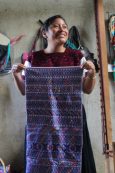 ll.”
ll.”
So we drove back up the hill and were lucky enough to find Francisca Santiz Gómez and her mother-in-law in the small well-constructed house with an incredible view of the mountains and valley below. Francisca was weaving and her mother-in-law was embroidering some textiles that they planned to send to the market in San Cristóbal. They were both dressed in traditional huipil and black skirts.
Francisca Santiz Gómez and her husband, Mateo de la Cruz Hernández are the driving force of the Grupo Artesanas de Yetón, which markets the work of about 30 local women. 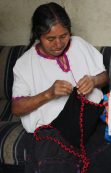 Mateo is a native of Aldama but Francisca was originally from San Andres Larrainzar before they were married.
Mateo is a native of Aldama but Francisca was originally from San Andres Larrainzar before they were married.
Francisca told us that Mateo was picking black berries with 2 of their kids but she would be happy to talk with us and show us her textiles. We spent over an hour looking through the pieces and my wife asking Francisca some technical we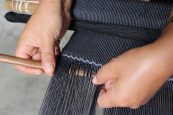 aving questions and she returned to her back strap loom to demonstrate some of the techniques my wife was asking about.
aving questions and she returned to her back strap loom to demonstrate some of the techniques my wife was asking about.
Mateo and the two kids returned from picking black berries and their teenaged daughter who was home visiting from nursing school in San Cristóbal started weaving. Francisca told us about some of her marketing efforts including a venture with a shoe maker she met at an exhibition who was making shoes from her textiles. She had a brochure of the shoes, which looked great and she said they were selling quite well in Mexico City. We found it fascinating that despite the home not having many modern conveniences that we take for granted, she pulled out a smart phone from her purse and showed us a video of her daughter weaving that a previous visitor ha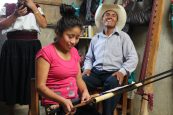 d posted on-line.
d posted on-line.
We bought quite a few things and even without haggling walked away feeling like we got great deals on everything. As we were saying our good byes, Mateo followed us to the car and presented us with a big bag of fresh black berries still warm from the sun.
